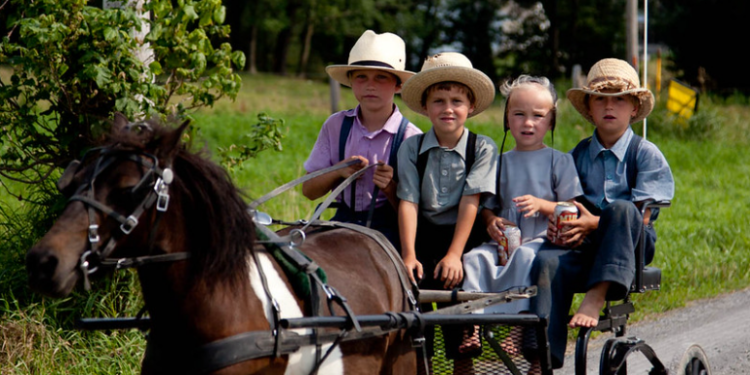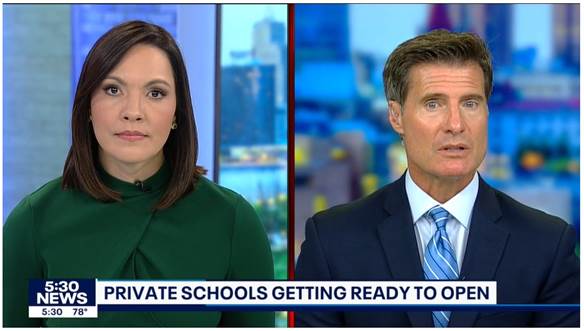Imagine it’s a beautiful fall day. You’re whizzing down country roads, enjoying the vibrant colors of red and yellow maples, when suddenly, a bright-orange triangle catches your eye. Slamming on the brakes, you realize that an Amish buggy is just ahead, and you curiously crane your neck, hoping for a glimpse of the plainly clad individuals inside.
Alas, your vehicle’s slowed pace leaves you little more than a glimpse of them, and you speed on, glad you’re heading back to modernity and its conveniences rather than stuck behind a horse.
Many of us would be loath to leave life as we know it and join the Amish community, but the fact is, they have a lot going for them. So when I recently ran across a few notes I had taken on the Amish school system, courtesy of John Taylor Gatto’s book “Weapons of Mass Instruction,” I stopped to read more closely.
In the 1970s, Mr. Gatto explained, the state of Wisconsin tried to force the Amish to assimilate into the state education system. Naturally met with resistance, the state accepted the following seven demands of the Amish—demands that place parents and the community at the heart of the school system.
Close to Heart and Hearth
“Schools within walking distance of home.”
Schools within walking distance of home are schools that are front and center in the neighborhood. Everyone knows what’s going on there, and there’s no chance of hiding bad behavior on the part of students or unacceptable indoctrination on the part of teachers.
A community school also provides a common interest for the neighborhood, involving people young and old in its upkeep and offering a place in which people can come together, meet each other, and bond with those with whom they have no connection except for the fact that they live in the same vicinity.
An added bonus? Community schools enable kids to get the daily exercise that they need to stay healthy and help them focus on their lessons. And because everyone is invested in the school, adults will naturally watch out for children making their way to and from the building every day, leaving little chance for the abductions that America has been alarmed about for years.
Individual Attention
“No school to be so large that pupils had to be sorted into different compartments and assigned different teachers every year.”
The massive consolidation of school districts in recent decades implies that bigger is better. Yet research tells us that large schools spawn more violence. When kids are in a community, surrounded by friends and siblings, they develop a sense of belonging, and the smaller the school, the more likelihood there is for positive peer pressure to do right.
Additionally, small schools ensure that students are more visible to teachers. If a teacher doesn’t teach a student to read in the first year, he can’t simply unload that child on another teacher in another part of the mammoth school building the next year and be done with the problem. Dwelling in a community means that teachers and students must work through academic and personality problems, finding real solutions rather than cosmetic fixes.
Time to Reset
“The school year would be no longer than eight months.”
Sometimes, we get so caught up in pushing ourselves to succeed that we forget to take a break. The longer school years and days that many currently push for may help increase academic performance, but are we more interested in said performance or in babysitting services?
The more hours that we keep students in school, the less time we, as families, have to spend with our children. And the longer that students are in school, the more alienated they are from their families and neighborhoods, as well as the outdoors and freedom. Thus, choosing healthy limits that allow for academic, familial, and free-time balance should be an important priority for any good school.
Parental Authority
“Important decisions would be under parental control, not that of bureaucrats.”
Parents hold the primary responsibility for children, a fact that’s increasingly unpopular in a world in which the state views itself as the omnipotent power in the lives of its citizens. By keeping their schools local, the Amish keep a hold on the reins of power, protecting their children and preserving their autonomy from the whims of the state.
Consistent Values
“Teachers hired were to be knowledgeable in, and sympathetic to, Amish values and rural ways.”
The Amish seem to understand that teachers spend a good chunk of their waking hours with their children, and as such, they possess great influence over their young minds. Thus, it’s essential that teachers hold the same values as the parents, for without them, a young child will quickly be influenced away from his faith, parents, and community.
Today’s parents are only just beginning to wake up to this fact; sadly, such realization often only comes after a “gender-affirming” or Marxist-friendly teacher has already captured the hearts and minds of the young ones in his or her classes. Had today’s parents been on guard like the Amish, insistent that teachers hold similar values to their own, the agenda in our schools might have taken a turn for the better long ago.
Teaching Wisdom, Not Just Knowledge
“Children were to be taught that wisdom and academic knowledge were two different things.”
Wisdom and academic knowledge are what many today refer to as education and schooling. Today’s education system fixates on the latter, teaching students to jump through hoops by checking the right boxes and getting the right credentials. Education, however, ministers to the whole individual, training the student in how to handle life in general, including the spiritual, mental, and emotional aspects.
By differentiating between wisdom and academic knowledge, the Amish guard against turning their children into “clever devils.” Such individuals have enough head knowledge to be dangerous but don’t understand or know the heart or soul aspect of life enough in order to reign in their base desires and live as responsible, upstanding members of society.
But when students learn both wisdom and knowledge, understanding the difference between each, they enter the real world as well-rounded individuals, possessing the character and responsibility to use their knowledge appropriately to succeed.
Education Beyond the Classroom
“Every student would have practical internships and apprenticeships supervised by parents.”
By insisting on apprenticeships, the Amish once again succeeded in differentiating between schooling and true education, as mentioned above.
But notice the second part of this condition—such training was to be done under the guidance of parents. Why? The simple reason is likely that parents know and love their children. They may not be “experts” with degrees in child psychology or early education, but they do know what makes their kids tick, and thus they’re better suited to suggest and lead them into paths and positions that will prepare them for their future work and calling.
Following the Amish Pattern
It’s not hard to see that our schools have problems. But in recent decades, we’ve tried to solve those problems by trying the most recent tech devices and educational theories one after another.
Perhaps all that we ever needed to do was try something simple, and the Amish pattern of family- and community-based schools may provide just such a pattern.
—
This article is republished with permission from The Epoch Times and may not be replicated elsewhere.
Image Credit: Flickr-Alvin Trusty, CC BY-NC-SA 2.0











![[downloaded during free trial]](https://oakmn.org/wp-content/uploads/2025/11/iStock-1430368205-120x86.jpg)

